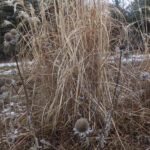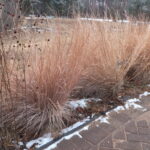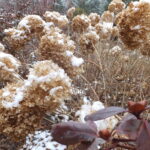Do you want to reduce the work in your annual spring cleaning of your property? Read on for some labor saving ideas that make your landscape better too!
Many gardeners and landscapers are reaping the benefits of not removing perennial plant stems, ornamental grass stalks and standing prairies in the Fall. These dried plants give interest during what is our longest landscape season in cold climates – winter! Leaving plants up during the winter months also benefits the environment. During the dormant season plants are refuges for beneficial insects, supply a natural source of food for birds and provide a frost blanket that allows the soil to absorb more life-giving moisture. However, how should these plants be managed in the spring? Resist the urge to simply cut them off and push them out to the curb for pick up.
Here are some tips that you can use for hassle-free Spring maintenance of your landscape:
Cut off ornamental and prairie grasses and lay them nearby as a natural mulch that will help reduce moisture loss and regenerate the soil.

This ornamental grass and Echinacea that provided winter habitat and food can be chopped and left to mulch in place.
“Chop and drop” plants with a hedge trimmer by cutting them up into little pieces. As you work your way down the plant you will create a natural mulch circle that is virtually indiscernible from the rest of the landscape.
Use a power weed whip to cut off and chop up plants very rapidly.
A mulching lawn mower can make quick work of perennial beds and leave a clean, level surface that new growth will emerge through.
Leaves and twigs can be left in place to nourish the soil. You can sprinkle a very light layer of new wood chips over these area if you desire a more finished look.
Leaves on your lawn? Run your mower over them once or twice to break them up and provide great, natural fertilizer for your yard.
Recognize that things often look a little dreary in early spring, but patiently anticipating new plant growth that will reinvigorate the area soon is the key to less work.

Warm season, native grasses, like this Little Bluestem can be cut back in late spring since new growth will not occur until then.
All properties require people to perform the work of maintenance or the landscape falls apart. However, upkeep doesn’t have to be meaningless drudgery. Embracing maintenance processes that produce multiple benefits for you, that enriches your landscape and contributes to abundance for the planet is a winning combination. Test out some of the tips in this article in a small way. Observe the results and then do more of what works best for you!
Get ready to enjoy Spring!

